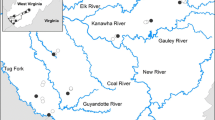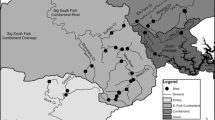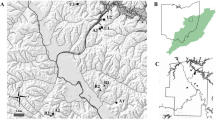Abstract
Mountaintop removal–valley fill mining results in the conversion of steep, forested headwater catchments to low gradient and open canopy channels. We compared the ecological functions of five reference stream channels to five constructed channels (age ranging from 3 to 20 years) on reclaimed mines in southern West Virginia. Variables included stream flow, habitat, water chemistry, riparian vegetation, organic matter (OM) processing, and invertebrate and amphibian communities. Although dissolved metal concentrations remained low, constructed channels produced significantly higher levels of conductivity and total dissolved solids as compared to reference streams. Macroinvertebrate and amphibian richness were comparable between constructed and reference channels; however, there was a distinct shift from sensitive lotic taxa in reference channels to tolerant lentic taxa in constructed channels. Constructed channels also had reduced OM decomposition rates. Nevertheless, constructed channels had significantly higher OM retention than reference channels, and consequently exhibited significantly higher overall OM processing and higher dissolved carbon concentrations. As the time since reclamation increased, we observed slight declines in conductivity and significant increases in total invertebrate richness. Our results provide measures of functional equivalencies between reference and constructed streams, which can serve as a basis for informed permitting and mitigation decisions in mined watersheds.






Similar content being viewed by others
References
Balcombe, C. K., J. T. Anderson, R. H. Fortney & W. S. Kordek, 2005a. Aquatic macroinvertebrate assemblages in mitigated and natural wetlands. Hydrobiologia 541: 175–188.
Balcombe, C. K., J. T. Anderson, R. H. Fortney, J. S. Rentch, W. N. Grafton & W. S. Kordek, 2005b. A comparison of wetland plant communities in mitigation and reference wetlands in the Mid-Appalachians. Wetlands 25: 130–142.
Barbour, M. T., J. Gerritsen, B. D. Snyder & J. B. Stribling, 1999. Rapid Bioassessment Protocols for Use in Streams and Wadeable Rivers: Periphyton, Benthic Macroinvertebrates, and Fish. EPA/2nd edn. United States Environmental Protection Agency, Washington, DC.
Benfield, E. F., 1996. Leaf breakdown in stream ecosystems. In Hauer, F. R. & G. A. Lamberti (eds), Methods in Stream Ecology. Academic Press, San Diego, CA.
Crump, M. L. & N. J. Scott Jr, 1994. Standard techniques for inventory and monitoring: visual encounter surveys. In Heyer, W. R., M. A. Donnely, R. W. McDiarmid, L. C. Hayek & M. S. Foster (eds), Measuring and Monitoring Biological Diversity. Standard Methods for Amphibians. Smithsonian Institution, Washington, DC: 84–92.
Finn, D. S., N. Bonada, C. Múrria & J. M. Hughes, 2011. Small but mighty: headwaters are vital to stream network biodiversity at two levels of organization. Journal of the North American Benthological Society 30: 963–980.
Fritz, K. M., S. Fulton, B. R. Johnson, C. C. Barton, J. D. Jack, D. A. Word & R. A. Burke, 2010. Structural and functional characteristics of natural and constructed channels draining a reclaimed mountaintop removal and valley fill coal mine. Journal of the North American Benthological Society 29: 673–689.
Gerritsen, J., J. Burton, & M. T. Barbour. 2000. A stream condition index for West Virginia wadeable streams. Tetra Tech, Inc., Owings Mills, MD.
Gingerich, R. T. & J. T. Anderson, 2011. Decomposition trends of five plant litter types in mitigated and reference wetlands in West Virginia, USA. Wetlands 31: 653–662.
Gomi, T., R. C. Sidle & J. S. Richardson, 2002. Understanding processes and downstream linkages of headwater systems. BioScience 52: 196–905.
Green, N. B. & T. K. Pauley. 1987. Amphibians and reptiles in West Virginia. University of Pittsburgh Press, Pittsburgh, PA.
Hartman, K. J., M. D. Kaller, J. W. Howell & J. A. Sweka, 2005. How much do valley fills influence headwater streams? Hydrobiologia 532: 91–102.
Hecnar, S. J. & R. T. M’Closkey, 1996. Regional dynamics and the status of amphibians. Ecology 77: 2091–2097.
Lindberg, T. T., E. S. Bernhardt, R. Bier, A. M. Helton, R. B. Merola, A. Vengosh & R. T. Di Giulo, 2011. Cumulative impacts of mountaintop mining on an Appalachian watershed. In Proceedings of the National Academy of Sciences. www.pnas.org/cgi/doi/10.1073/pnas.1112381108.
Lowe, W. H., G. E. Likens & M. E. Power, 2006. Linking scales in stream ecology. BioScience 56: 591–597.
McClurg, S. E., J. T. Petty, P. M. Mazik & J. L. Clayton, 2007. Stream ecosystem response to limestone treatment in acid impacted watersheds of the Allegheny Plateau. Ecological Applications 17: 1087–1104.
McCulloch, W. L., W. L. Goodfellow & J. A. Black, 1993. Characterization, identification and confirmation of total dissolved solids as effluent toxicants. Environmental Toxicology and Risk Assessment 2: 213–227.
McDowell, W. H. & G. E. Likens, 1988. Origin, composition, and flux of dissolved organic carbon in the Hubbard Brook valley. Ecological Monographs 58: 177–195.
Merovich, G. T. Jr. & J. T. Petty, 2007. Interactive effects of multiple stressors and restoration priorities in a mined Appalachian watershed. Hydrobiologia 575: 13–31.
Merovich, G. T., J. M. Stiles, J. T. Petty, P. F. Ziemkiewicz & J. B. Fulton, 2007. Water chemistry-based classification of streams and implications for restoring mined Appalachian watersheds. Environmental Toxicology and Chemistry 26: 1361–1369.
Merriam, E. R., J. T. Petty, G. T. Merovich, J. B. Fulton & M. P. Strager, 2011. Additive effects of mining and residential development on stream conditions in central Appalachian watershed. Journal of the North American Benthological Society 30: 399–418.
Meyer, J. L. & J. B. Wallace, 2001. Lost linkages and lotic ecology: rediscovering small streams. In Press, M. C., N. J. Huntley & S. Levin (eds), Ecology: Achievement and Challenge. Blackwell Science, Oxford, UK: 295–317.
Mount, D. R., D. D. Gulley, J. R. Hockett, T. D. Garrison & J. M. Evans, 1997. Statistical models to predict the toxicity of major ions to Ceriodaphnia dubia, Daphnia magna, and Pimephales promelas (fathead minnows). Environmental Toxicology and Chemistry 16: 2009–2019.
National Research Council, 2001. Compensating for Wetland Losses Under the Clean Water Act. National Academy Press, Washington, DC.
Palmer, M. A., E. S. Bernhardt, W. H. Schlesinger, K. N. Eshleman, E. Foufoula-Gerogiou, M. S. Hyndryx, A. D. Lemly, G. E. Likens, O. L. Loucks, M. E. Power, P. S. White & P. R. Wilcock, 2010. Mountaintop mining consequences. Science 327: 148–149.
Pechmann, J. H., R. A. Estes, D. E. Scott & J. W. Gibbons, 2001. Amphibian colonization and use of ponds created for trial mitigation of wetland loss. Wetlands 21: 93–111.
Petty, J. T. & D. Thorne, 2005. An ecologically based approach to identifying restoration priorities in an acid-impacted watershed. Restoration Ecology 13: 348–357.
Petty, J. T., J. B. Fulton, M. P. Strager, G. T. Merovich Jr, J. M. Stiles & P. F. Ziemkiewicz, 2010. Landscape indicators and thresholds of stream ecological impairment in an intensively mined Appalachian watershed. Journal of the North American Benthological Society 29: 1292–1309.
Pollio, C. A., 2005. Effects of pH and heavy metal concentrations on amphibian breeding and community structure on a reclaimed pyrite mine in northern Virginia. Catesbeiana 25: 51–75.
Pond, G. J., M. E. Passmore, F. A. Borsuk, L. Reynolds & C. J. Rose, 2008. Downstream effects of mountaintop coal mining: comparing biological conditions using family- and genus-level macroinvertebrate bioassessment tools. Journal of the North American Benthological Society 27: 717–737.
Poplar-Jeffers, I. O., J. T. Petty, J. T. Anderson, S. J. Kite, M. P. Strager & R. H. Fortney, 2009. Culvert replacement and stream habitat restoration: implications from brook trout management in an Appalachian watershed, USA. Restoration Ecology 17: 404–413.
Rosgen, D. L., 2001. A practical method of computing streambank erosion rate. Proceedings of the Seventh Federal Interagency Sediment Conference 2: 9–15.
Saunders, D. L., J. J. Meeuwig & A. C. J. Vincent, 2002. Freshwater protected areas: strategies for conservation. Conservation Biology 16: 30–41.
Shaffer, H. B., R. A. Alford, B. D. Woodward, S. J. Richards, R. G. Altig & C. Gascon, 1994. Quantitative sampling of amphibian larvae. In Heyer, W. R., M. A. Donnelly, R. W. McDiarmid, L. C. Hayek & M. S. Foster (eds), Measuring and Monitoring Biological Diversity. Standard Methods for Amphibians. Smithsonian Institution, Washington, DC: 130–131.
Speaker, R., K. Moore & S. Gregory, 1984. Analysis of the process of retention of organic matter in stream ecosystems. Verhandlung der Internationalen Vereinigung für Angewandte und Theoretische Limnologie 22: 1835–1841.
USACOE, 2007. Functional Assessment Approach for High Gradient Streams in West Virginia. United States Army Corps of Engineers, Huntington, WV.
USACOE & VADEQ, 2007. Unified Stream Methodology. United States Army Corps of Engineers, Norfolk, VA, and Virginia Department of Environmental Quality, Richmond, VA.
USEPA, 2005. Mountaintop Mining/Valley Fills in Appalachia Final Programmatic Environmental Impact Statement. United States Environmental Protection Agency, Region 3, Philadelphia, PA. EPA-9-03-R-05002.
Veselka, W. V., J. T. Anderson & W. S. Kordek, 2010. Using dual classifications in the development of avian wetlands indices of biological integrity for wetlands in West Virginia, USA. Environmental Monitoring and Assessment 164: 533–548.
Wallace, J. B., S. L. Eggert, J. L. Meyer & J. R. Webster, 1997. Multiple trophic levels of a forest stream linked to terrestrial litter inputs. Science 277: 102–104.
Wilson, J. D. & M. E. Dorcas, 2003. Effects of habitat disturbance on stream salamanders: implications for buffer zones and watershed management. Conservation Biology 17: 763–771.
Wipfli, M. S., J. S. Richardson & R. J. Naiman, 2007. Ecological linkages between headwaters and downstream ecosystems: transport of organic matter, invertebrates, and wood down headwater channels. Journal of the American Water Resources Association 43: 72–85.
Acknowledgments
We would like to thank Gabriel Strain for his assistance with amphibian sampling and identification, as well as George Merovich and Eric Merriam for their assistance with R programming. We are also grateful to Gina Bays, Mitch Kalos, Alex Neal, Kenny Daniel, John McHale, and Randy Maggard for their assistance with this project. This paper was prepared with the support of a grant from the U.S. Office of Surface Mining to JTP, PFZ, and JTA.
Author information
Authors and Affiliations
Corresponding author
Additional information
Handling editor: David J. Hoeinghaus
Rights and permissions
About this article
Cite this article
Petty, J.T., Gingerich, G., Anderson, J.T. et al. Ecological function of constructed perennial stream channels on reclaimed surface coal mines. Hydrobiologia 720, 39–53 (2013). https://doi.org/10.1007/s10750-013-1619-1
Received:
Revised:
Accepted:
Published:
Issue Date:
DOI: https://doi.org/10.1007/s10750-013-1619-1




